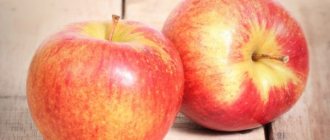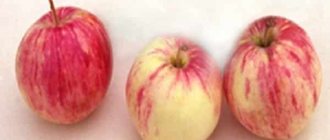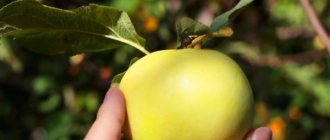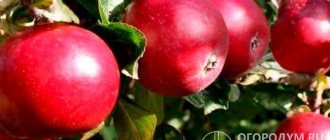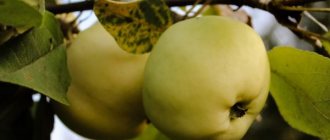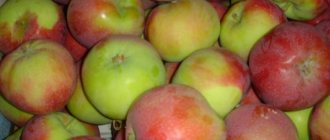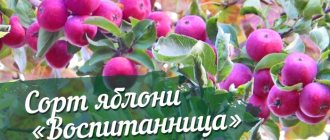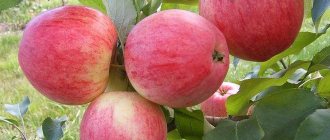The Idared apple tree is a productive, but very heat-loving variety of American selection. Due to its keeping quality and excellent transportability, good taste and attractive appearance of the fruit, the variety is especially often grown in commercial gardens in the southern regions of Russia, although this variety can often be found in private farms, including in the middle zone and the Moscow region.
Idared apple trees (pictured) are very popular in many countries around the world and are widely used in industrial plantings
Let's look at the main features of the variety in the table:
| Parameter | Characteristic |
| Culture | Apple tree (Malus domestica Borkh.) |
| Variety | "Idared" |
| Tree height | Medium height: from 3 to 6 m (depending on the rootstock) |
| Precociousness | Medium: 5-6 years after planting (on seed rootstock) |
| Period of (storage) consumption | Late winter: characterized by long shelf life (until April – May) |
| Terms of removable (technical) maturity | Last ten days of September |
| Type of fruiting | Mixed |
| Productivity | Up to 50 t/ha |
| Size and weight of fruits | Medium: about 140 g, maximum – up to 170 g |
| Shape and color | The apples are flat-round or round, slightly conical towards the top. The color when picked is light green, when fully ripe it is greenish-yellow with a bright crimson or dark carmine blush - continuous and covering almost the entire surface |
| Fruit pulp | Dense, pale yellow, with a weak aroma, very juicy when picked, becoming loose during long-term storage |
| Tasting assessment (taste qualities) | 4.0-4.2 points (out of 5) – taste very good, sweet and sour |
| Purpose of fruits | Dessert |
| Sustainability | High winter hardiness and drought resistance; scab and powdery mildew are affected to a moderate degree; not susceptible to brown spot |
| Year of inclusion in the State Register of the Russian Federation | 1986, 2017 |
| Recommended growing regions | North-Western (in the Kaliningrad region), North Caucasus, Nizhnevolzhsky |
| Originator | Federal State Budgetary Institution "North Caucasus Federal Scientific Center for Horticulture, Viticulture, Winemaking" (Krasnodar) |
Origin and zoning
“Idared” was obtained in 1935 by crossing the “Wagner” and “Jonathan” apple trees. Selection work was carried out at an experimental station in Idaho (USA). In the former USSR, the variety has been tested since 1974 and in 1986 was included in the State Register of the Russian Federation as recommended for the southern regions - the North Caucasus and Lower Volga. It became widespread primarily in the Krasnodar Territory, where significant areas were allocated for the industrial cultivation of this variety. As a result of zoning, “Idared” was able to adapt to more severe climatic conditions, after which in 2021 it was officially approved for cultivation in the Kaliningrad region.
The intensity of the color of fruits and their taste largely depend on the weather and climatic conditions of the growing region
“Idared” itself was also used to develop a number of new varieties of apple trees, for example, “Cossack Kuban”.
Features of the plant
The variety is classified as medium or vigorous. Trees develop especially quickly in the first 3-4 years of life; after 11 years, growth practically stops. Depending on which rootstock was used - a dwarf clonal or a vigorous pome - the height of a ten-year-old tree will be 3 or 6 m, respectively .
The trunk is straight, powerful and strong. The crown is broadly oval or spherical, heavily leafy; due to the high excitability of reserve buds on skeletal branches, it is prone to thickening, especially after freezing or excessive pruning. It needs to be thinned out at least once a season, while maintaining moderation.
The crown is prone to thickening and requires regular but moderate pruning
Skeletal branches are located at an angle of 35-80, most often 45 degrees relative to the trunk. In the main part they rise slightly. The shoots are round in cross-section, moderately thick, slightly geniculate. Lentils are slightly streaked and bright, usually slightly elongated. The excitability of ordinary buds and their shoot-forming ability are average. The bark is grey-brown. The trunk is smooth, not flaking, the shoots are slightly hairy. In annual plants, the pubescence is more pronounced, and their branches are rather gray in color.
The leaves are moderately complex, noticeably elongated and even (only slight clockwise curling is allowed). They extend from the stem almost at a right angle. Their shape can be oval or ovoid, the base can be sharp or rounded. The edges are usually coarsely wavy. The upper part is smooth, with a slight gloss, painted in a rich green color, the lower part is lighter, with noticeable fluff. The leaves of seedlings may have a slight bluish or blue tint. Stipules are slightly curved, lanceolate in shape. The petioles are quite thin.
The root system is located relatively close to the soil surface - this is one of the reasons for the low frost resistance of the tree.
Agricultural technology
Caring for Idared is no different from growing other fruit crops in the garden. The main requirements are to observe regular watering, chemical treatment, and loosening.
Watering
A prerequisite for proper care is regular summer watering. Use only water that has been left in the sun. One adult Idared tree will need up to 3 buckets of liquid.
Fertilizer
Adding nutrients is another mandatory condition for caring for an Idared apple tree. It is recommended to focus on complex fertilizing. Many gardeners successfully use organic matter - mullein infusion.
See also
Detailed description and main characteristics of the Martovskoye apple tree varietyRead
Pruning and crown formation
It is recommended to carry out annual pruning, otherwise the tree will quickly grow and numerous side shoots will appear. It is better to postpone the process until the fall; in the spring, only inspect the plant and cut out branches damaged by winds or frost.
Preventive treatment against insects and diseases
The tendency to disease is the main reason to use regular treatments against infection. It is recommended to focus on copper-containing compounds. The frequency of tree irrigation is at least three times per season. Use chemicals against pests, but you can prepare folk remedies, especially before harvesting.
Preparing a tree for wintering
Low resistance to frost requires annual sheltering of the apple tree. Idared must be wrapped in spruce branches, straw, and burlap. The root trunk must be covered with a thick layer of mulch (peat, compost) or spruce branches spread out. In winter, carry out high hilling with snow - the snowdrift will serve as excellent protection from frost.
Fruiting
Important advantages of the Idared apple variety are productivity, yield and excellent marketable quality of the fruit.
The early fruiting rate of the trees is quite high. On a semi-dwarf rootstock, the harvest can be obtained within 3-4 years after planting, on a vigorous rootstock - after 5-6 years. Fruiting is annual . The most productive fruit formations are ringlets. Ovaries are also formed on fruit twigs, spears and annual growths.
Young trees produce up to 30 kg of apples per season, and the yield of a 10-year-old apple tree under optimal conditions is 90-100 kg
In commercial gardens, one hectare can produce 30-40, in favorable years - up to 50 tons of fruits.
Productive age lasts on average until 30 years.
Flowering and ovary formation
The buds form and bloom early, usually in late April or early May. The flowers are saucer-shaped. The petals are soft pink, lighter towards the center. The column of pistils is short, without pubescence. Stigmas and anthers are located at approximately the same height. The flowers are collected in fairly large corymbose inflorescences, with ovaries formed on two or three of them.
Flowering lasts a long time, intensity 3-4 points. Pollen viability – 42-87%
The activity of ovary formation depends on the type of pollination:
| Type | Fruit set level |
| Self-pollination | 2,4% |
| Artificial pollination | 7% |
| In the presence of active pollinators | 24% |
The best pollinators for Idared are:
- Wagner;
- Gloucester;
- Jonagold;
- Ruby Dooks;
- Rusavka;
- Celeste;
- Red Delicious.
“Idared” itself is also a good pollinator: the presence of this tree on the site helps to increase the overall yield of apple trees.
The largest number of ovaries are formed on two to three year old branches. In good years, whole garlands of apples can be placed on them. On the one hand, this gives the tree a decorative appearance, on the other hand, the branches can bend and break under the weight of the fruit. In such cases, it is necessary to install supports. The fruits are arranged evenly, without bare areas, on the ringlets - 2-3 apples.
Commercial and consumer qualities of fruits
The apples of this variety are medium in size, weighing 140-170 g, but not less than 100.
The largest weight of the Idared apple (224 g) was recorded in the Krasnodar Territory.
The shape of the fruits is flat-round, the largest ones are slightly conical, with inconspicuous ribs. The skin is glossy, thin and elastic, but durable; Smooth to the touch, with a slight waxy coating. The main color of the fruit is light green. As they ripen, they turn yellow and a raspberry or carmine blush appears with stripes and streaks. The photo of Idared apples clearly shows that it is almost continuous and covers the main part of the surface. Subcutaneous points are few in number, but large. Merging, they create characteristic whitish stripes, which gives the apples an original marbled effect.
The attractiveness of the appearance of the fruit is estimated at 4.7 points (out of 5)
The saucer and funnel are quite narrow and deep, the funnel is rusty. The calyx is closed, small, the subcalyx tube is cylindrical, relatively large. The heart is small, shaped like a turnip. The axial cavity is narrow and may be separated from the triangular seed chambers or connected to them through a thin slit. The peduncle is medium.
When picked, apples are very juicy, slightly crispy, sweet and sour. The pulp is light cream or pale yellow, closer to the skin the shade is more saturated. By the time of ripening, the texture of the pulp is dense, some time after collection it becomes fine-grained, and with prolonged storage it becomes quite loose.
The taste is considered average or good, the tasting score is 4-4.2 points (previously it was 4.5, but has recently decreased due to the emergence of new dessert varieties). The aroma is medium or weak.
Despite the "official" downgrade in status, many gardeners still rate the taste of these apples very highly.
“Idared” refers to late-winter varieties; accordingly, apples of this variety acquire the best taste in February, and immediately after picking they may seem somewhat bland or too sweet. They are recommended to be consumed fresh in winter, as well as used for processing.
According to biochemical studies conducted by VNIISKP specialists, the sugar acid coefficient (SAC) is 17.2. The fruits contain:
| Nutrients and beneficial substances | Quantity per 100 g of product |
| Vitamin C (ascorbic acid) | 11.5 mg |
| Sahara | 10.5 g |
| Acids | 0.6 g |
| P-active substances | 120 mg |
Harvest and storage
Apples are usually harvested in late September, sometimes at the beginning of October. The total marketability is 88-92%, of which 10-15% of apples are of the highest grade and 40-50% are of the first grade. In cold or rainy summer conditions, these figures may decrease. Occasionally, after harvesting, fruits may become affected by subcutaneous spotting. The risk increases with high air humidity.
Ripe apples stay on the tree for a long time without falling off, sometimes until frost
Important characteristics of the fruit include excellent transportability and excellent keeping quality. In a cellar or in a special storage apples can last 5-6 months, that is, until the end of March, in the refrigerator - until June.
According to some reviews, Idared apples can be stored for up to two years - while their pulp will be greatly loosened, but will not rot.
Landing
Deadlines
Favorable time for planting seedlings:
- In the spring before the buds begin to bloom;
- In autumn, a month before the onset of frost.
Autumn planting will allow the seedlings to adapt to a new location during the dormant period and begin to grow with the onset of warmer weather.
When planting in spring, it is important not to miss the deadline. Delay will reduce survival rate and require more watering costs. For the middle band, the optimal time is:
- In spring - early April,
- In autumn - late September - early October.
Technology
Work on planting seedlings begins at least a week in advance with the preparation of the planting pit. The size of the hole is 100-120 cm in diameter, and the depth is at least 80 cm and directly depends on the size of the root system.
The roots should be free and not bent. The root collar is located 3-5 cm above the soil level. The top layer of soil mixed with fertilizers and humus is poured into the bottom of the hole. In order to improve air exchange on heavy soils, I add river sand and fine gravel. On light sandy soils, fertility is improved by adding peat and humus.
Attention! Mineral fertilizers must be thoroughly mixed with the soil to prevent direct contact with the roots. Fresh manure is not brought into the pit to avoid burning the root system.
Young seedlings are tied to a wooden stake located on the north side of the tree.
Look at the video about the main secrets of planting apple trees:
Scheme on different rootstocks
Different types of rootstocks provide distinctive tree canopy features. This circumstance is taken into account when planting apple trees. It is necessary to take into account what crown size adult plants will have, so that they grow freely to the sides and do not stretch into the sky. Trees are planted according to the following scheme:
- On a semi-dwarf rootstock - 4.0 x 1.5 m, 4.5 x 2.0 m;
- On a medium-sized rootstock - 4.5 x 2.0 m, 4.5 x 2.5 m;
- On a dwarf rootstock - 4.0 x - 1.0 m, 4.5 x 1.5 m.
Scheme of planting apple trees on different rootstocks.
Vaccinations
The apple tree takes root well on any rootstock. More often, grafting is used in the cleft, behind the bark, or in the side cut. By budding a bud, the variety is grafted onto branches into the crown of old trees.
Watch a video about three methods of vaccination:
Features of cultivation
The variety is relatively drought-resistant, but since the roots do not go deep into the soil, the tree needs regular watering in hot weather. Winter hardiness is low: at temperatures below −20 ℃ trees often freeze and die. Even in mild winter conditions, it is advisable to create insulation for the trunk and around the trunk. In the spring, when return frosts occur, some of the flowers or ovaries may be damaged.
In the first years after planting, the tree experiences an increased need for nitrogen.
The variety has a fairly high immunity to brown spot, and is moderately affected by scab and powdery mildew. The latter is especially dangerous in rainy years. Of the pests, the plant is primarily threatened by aphids, codling moths and copperheads.
For those interested in winter apples, we also suggest getting acquainted with the varieties “Lobo”, “Spartan” and “Bogatyr”.
How to plant an apple tree on a plot
To obtain a regular harvest, it is important to plant the crop correctly and follow all the rules for care and cultivation.
Deadlines
You can plant seedlings in open ground in early spring, when the buds are dormant. The seedling can also be planted in the ground in the fall at the end of September.
Important. Autumn planting of apple tree seedlings will allow them to strengthen their roots and activate growth. This period reduces the risk of disease formation.
Site selection and preparation
A correctly selected planting site accelerates the growth of the seedling. The planting site must be cleared of debris and weeds. You must first prepare the hole. The diameter of the planting hole should be at least 100 cm. However, the size can be smaller if the roots are not too developed.
In order for the plant to develop, it is necessary to take into account the following features when choosing a site:
- the landing site must be illuminated;
- there should be no nearby groundwater in the place where the cuttings are planted;
- Near the trees there should not be any nearby trees that will shade the crop.
Before planting the cuttings, it is necessary to fertilize the area. To prepare a nutrient mixture for a planting hole, add one part humus, two parts soil and 200 grams of superphosphate. The resulting mixture is filled with the planting hole.
Schemes for placement of young trees
Between seedlings it is necessary to maintain a distance of at least 5 meters. This distance is enough so that the crop does not interfere with the free development of the roots. When planting seedlings, a distance of at least 3 meters must be maintained between rows.
Landing technology
The procedure for planting seedlings involves the following algorithm of actions:
- place the seedling in liquid with a growth activator for 2 hours;
- make a hill from the nutrient mixture in the planting hole;
- install a wooden support in the hole;
- place the seedling, straightening the roots;
- sprinkle with soil and compact.
After planting, the apple tree seedling must be watered with plenty of warm water. The tree must also be fixed to a support.
Reviews from gardeners
Yana, 43 years old, Yeysk
We inherited the apple tree along with the plot, so we got it as an adult. A very prolific variety, it has never produced less than 90-95 kg, and there are almost no fallers, even if we delay the collection a little. Children love sweet apples more, so they ignore the harvest, but it’s just perfect for my husband and me. The apples are very large and juicy, especially when they have been lying in the basement for some time, the most delicious variety, in my opinion. And they are large, one is enough to fill you up completely.
Mikhail, 55 years old, Abinsk
We have been keeping the dacha for a long time; we have been growing Idared for about fifteen years. There are three trees, all literally strewn with apples in the fall. Maintenance does not cause any particular problems, except that there was a period when the pruning was a little neglected, because of this the crowns became very untidy. Then, on the contrary, they overdid it with shortening, and as luck would have it, they began to grow even more. But in general we have already dealt with this. The apples are not bad, quite juicy, especially closer to spring; it’s definitely better not to touch them until February. We eat mostly fresh, although sometimes my wife lets me eat charlotte, which is also good.
Maria, 36 years old, Temryuk
We recently bought a plot of land; we chose this variety because we love Idared apples and buy them often. Our hopes were fully justified; our own fruit turned out to be much better than store-bought fruit. The skin is very thin, we never peel it, the flesh is tender, crispy, refreshing, not oversweetened. I won’t say that caring for trees is very difficult: of course, we try to cover the trunk in the winter, we need to thin out the crown in the spring, but compared to the return in terms of yield, these are mere trifles.
Variety varieties
The taste and excellent presentation of Idared fruits are used to obtain new types. Each variety has advantages that it is recommended to familiarize yourself with before breeding apple trees.
Idared dwarf apples
There is a difference - the quality of the mother variety Idared is preserved. Wood has the following advantages:
- simple and quick harvesting;
- accelerated fruiting;
- good fruit taste;
- compactness.
The taste and appearance do not change. But apples can be more sour.
Technical apple trees
They bear fruit for 40 years. But this characteristic does not make the taste of apples worse. The plant is more resistant to low temperatures than other species.
Columnar
In this variety of Idared apple trees, the fruits form directly on the trunk. The apples have an attractive crimson color, and the main shoot is densely strewn with fruits. The height of an adult apple tree is no more than 2 m. The width is half a meter. The root system is quite developed, which makes caring for the plant easier. Thanks to its powerful roots, the tree receives the necessary nutrients.
